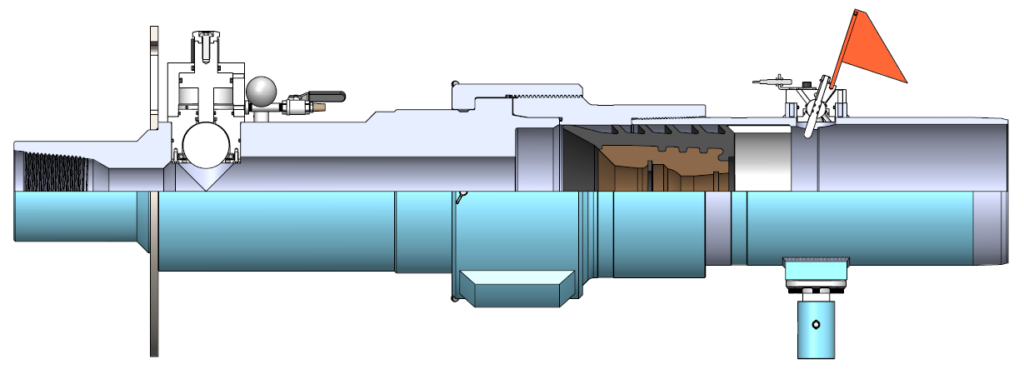
Cement Head Pump Through Plug
Good cement bonds are required when cementing well bore casings into wells. Poor cement bonds can result in formation pressures and fluids breaching to the surface or into other formations downhole. This will result in surface or underground blowouts and a loss of well control.
Cement bonds are usually better in vertical wells than those found in directional or horizontal wells. It is usually more difficult to centralize casing in horizontal wells than vertical wells. Cement slurries will usually find the easiest circulation path from the bottom of the well to surface. On directional wells, this path is usually the upper portion of the horizontal well while the casing lies on the lower portion of the well. Movement of the casing during cement circulation is usually the best way to disrupt any type of cement channeling and reduce torsional loads to the casing and connections. Rotating and reciprocating the casing can create alternating laminar and turbulent flows of the cement, reducing channeling, and trapped drilling fluids.
Currently, some cement heads require piping tied to the top of the head, impeding any rotation. Some cement heads without piping may only allow rotation or reciprocation independently. Other types will allow rotation and reciprocation simultaneously, but require casing movements or fluid pumping to stop, to load plugs or to divert flow.
The newly designed Casing Cement Head Pump Through Plug (CMT-PTP) allows rotation, reciprocation, pumping and plug launching simultaneously. The top of the CMT-PTP is connected directly to the top drive, while the bottom of the CMT-PTP is connected directly to the casing. This allows rotation and reciprocation of the casing simultaneously. The top plug (located inside the CMT-PTP) has a through bore, and all circulations pass directly through the plug. Deployment of the through bore top plug from the CMT-PTP is achieved by launching a ball that seats inside the through bore of the top plug. When the ball seats inside the top plug, the pressure above the plug forces the top plug down the casing in the same manner that a typical solid top plug is moved. The launching of the top plug ball can be achieved manually or by remote control. The CMT-PTP does not have to be located at the rig floor when the top plug is remotely launched as remote activation can carry a distance of 500 feet. The top plug ball can be launched on the fly (without stopping pumps) if required. The plug can also be launched without stopping casing movements.
APPLICATION
- Cementing casing in vertical, directional, and horizontal drilled well bores.
FEATURES
- Rotation and reciprocation of the casing at the same time during casing cementing.
- Top plug can be launched without stopping pumping procedures or casing movements.
- No hazardous cementing lines are tied into cement head.
- No stopping cement process to tighten leaks as cement headlines are eliminated.
- No premature launching of top plugs (vacuum) during valve changing, pump stoppage
- • Cement Head equipped with Safety
- Locking Pin to stop premature launch.
- Mechanical and electronic monitoring system to show launching (movement) of the top plug.
- Designed to work with conventional and slant style drilling rigs.
- Mechanical or remote launching of plugs
- Latch down plugs and rings available
- Explosion proof system (Class #1, Division #2)
BENEFITS
- Increase better cement bonds in any type of well to be cemented.
- Quicker and safer operations of the cement head, minimizing the risk of getting casing stuck during the cementing process.
- Decrease chances of air voids in cement and wet shoes
- Decrease volume of cement slurry required (cost savings)